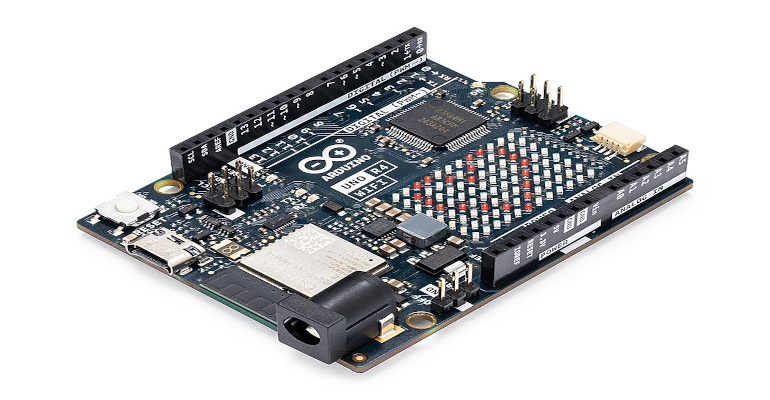Arduino’s Latest Board Targets Cloud Applications
Powered by 32-bit microcontroller, latest-generation UNO R4 WiFi board connects to the Arduino Cloud and other platforms for IoT projects.

With embedded projects increasingly requiring cloud connectivity, Arduino has significantly revised its UNO board. The new UNO 4 board is powered by a 32-bit microcontroller and comes in two versions: the basic UNO R4 Minima and comprehensive UNO R4 WiFi, meeting the budgetary and creative needs of the maker community.
While Arduino has been developing more products for enterprise applications, the company has not forgotten its core maker community, whose applications increasingly are used in IoT networks.
Preserving the standard form factor, shield compatibility and 5 V power supply of the popular UNO R3, the UNO R4 integrates the RA4M1 processor from Renesas with up to 16x the clock speed, memory and flash storage. Based on an Arm® Cortex®-M4 core, the RA4M1 microcontroller on the Arduino UNO R4 features a clock speed of 48 MHz for higher processing power.
To accommodate more complex projects, the UNO R4 is fitted with 32 kB of SRAM and 256 kB of flash memory. Plus, the Arm® Cortex®-M4 core features a Floating Point Unit (FPU), providing a huge performance boost for certain applications. The board also support software scalability, allowing easy upgrades for projects made with UNO R3 or Leonardo.
To accommodate requests from the Arduino community, the UNO R4 board upgrades the USB port upgraded to US B-C® and the maximum power supply voltage increased to 24 V with an improved thermal design. The board provides a CAN bus, enabling users to minimize wiring and execute different tasks in parallel by connecting multiple shields, as well as two SPI and two I2C serial ports. The board also includes a 12-bit analog DAC and operational amplifier.
By keeping the pinout, voltage and form factor similar to UNO R3, Arduino ensures maximum hardware and electrical compatibility with existing shields and projects while allowing the UNO R4 boards to be a high-performance drop-in replacement.
The UNO R4 WiFi version comes with an Espressif ESP32-S3 module for Wi-Fi® and Bluetooth® Low Energy connectivity. The bright 12x8 red LED matrix is ideal for creative projects using animations or for plotting sensor data without requiring additional display hardware.
Plug-and-Play
With various compatible modules that can be connected via the Qwiic I2C connector, combined with the large ecosystem of shields for UNO already in the market, UNO R4 WiFi provides a plug-and-play experience that allows creating projects without soldering, breadboards or manual wiring. For more advanced uses, there are also additional pins to turn off the microcontroller while keeping the RTC powered by an external buffer battery.
For makers seeking more processing power without the additional features, the basic UNO R4 Minima provides a cost-effective option. With the HID over USB capability, makers can simulate a mouse or a keyboard to create quick and innovative interfaces with minimal effort.
Spencer Chin is a Senior Editor for Design News covering the electronics beat. He has many years of experience covering developments in components, semiconductors, subsystems, power, and other facets of electronics from both a business/supply-chain and technology perspective. He can be reached at [email protected].
About the Author(s)
You May Also Like





